Bidhannagar
| Bidhannagar Kolkata বিধাননগর | |
|---|---|
| Satellite City and Neighbourhood of Kolkata | |
|
The skyline of Bidhannagar's IT hub, Sector V. | |
| Nickname(s): Salt Lake City | |
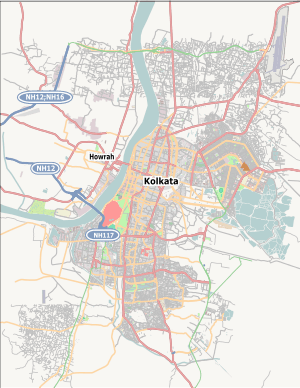 Bidhannagar Kolkata Location in Kolkata | |
| Coordinates: 22°35′N 88°25′E / 22.58°N 88.42°ECoordinates: 22°35′N 88°25′E / 22.58°N 88.42°E | |
| Country |
|
| State | West Bengal |
| District | kolkata |
| City | Kolkata |
| Founded by | Siraj-Ud-Daulah |
| Named for | Bidhan Chandra Roy |
| Government | |
| • Body | Municipal Corporation |
| Elevation | 11 m (36 ft) |
| Population (2011) | |
| • Total | 218,323 |
| • Density | 15,590/km2 (40,400/sq mi) |
| Languages | |
| • Official | Bengali, English |
| Time zone | IST (UTC+5:30) |
| Vehicle registration | WB-07(Commercial Vehicles), WB-08(Private Vehicles) |
| Lok Sabha constituency | Dum Dum |
| Vidhan Sabha constituency | Rajarhat New Town |
| Website | bidhannagar.org |
Bidhannagar (Bengali: বিধাননগর), or Salt Lake City (Bengali: সল্ট লেক সিটি) as it is popularly called, is a planned satellite town in the Indian state of West Bengal. It was developed between 1958 and 1965 to accommodate the burgeoning population of Kolkata.
It is now a hub of economic and social expansion and is famous as the centre for IT in the city. Dr. Bidhan Chandra Roy, the then Chief Minister of West Bengal, was instrumental in formulating the plan to build this satellite area, and the township was named Bidhan Nagar in his honour.The city was built on a reclaimed salt-water lake, which gave rise to its popular name of "Salt Lake City".The areas under the two constituencies Rajarhat Gopalpur & Rajarhat NewTown is included in Bidhannagar Municipal Corporation.
Demographics
At the 2011 census, Bidhannagar had a population of 218,323 (Males 111,363; Females 106,960). Bidhannagar has an average literacy rate of 90.44% (higher than the national average of 74%),[1] with male literacy of 93.08% and female literacy of 87.69%.[2]
Geography
Bidhannagar is located at 22°35′N 88°25′E / 22.58°N 88.42°E.[3] It has an average elevation of 11 metres (49 ft). Demographically this is the most enriched part of Kolkata as it is very near to the airport. Many of the fast-growing IT companies are located in this area.
History
The earliest known reference of Bidhannagar in history is that on 17 June 1756, Siraj ud-Daulah, the Nawab of Bengal, camped at this place to chalk out the strategy for attacking the British East India Company at Fort William. The said attack led to the infamous massacre in Black Hole Prison that occurred on 20 June. After the defeat of Siraj ud-Daulah in 1757 in the Battle of Plassey, the right and title of these swampy salt water lakes remained with Mir Jafar and his descendants, who were supported by the Company who had won in that battle. Gradually, the right of the lakes went to the hands of local landlords and there happened a spurt in the pisciculture in the area.
In 1865, the British officially started reclaiming these salt water bodies by connecting it with Mahratta Ditch (canal). In 1878, the Government leased out the right of the place to Nandalal Das and Durgacharan Kundu till 1887. On 30 April 1890, the Government again advertised in the newspaper and gave the leasehold right to the highest bidder, Bhabanath Sen, who offered INR 3400 for the rights. The said right ended in 1899. In 1906, the Government again leased out the lakes for 10 years to the highest bidder against INR 9750.
Development
On 16 May 1955, a Calcutta Gazettee Government notification was published, which stated that the Governor of West Bengal was pleased to acquire 8,760.50 acres (35.4525 km2) of Bheries (pisciculture area) under the Sec1.(4) of Land Acquisition Act, 1884. The basic area included the mauzas, that is, Hadia, Nayabad, Karimpur, Jagatipota, Mukundapur, Pargachhia, Tentulbari, Panchpota and a few minor others. In 1958, the Chief Minister Dr. Bidhan Chandra Roy visited the area for the first time. The global tender for the reclamation of the salt water lakes was floated in 1959 and was won by M/s. "Invest Import" Company of Yugoslavia. These marshy, shallow salt water lakes were chosen as the site for developing the auxiliary township of Kolkata. Salt Lake City, later renamed as Bidhannagar,[4] as recognition to one of its founders, Dr. Roy.
The area was a conglomerate of several salt lakes in a low-lying saucer shaped area which was lower than the adjoining drainage channels. The only available method of development was to fill the salt lakes to a higher level which would permit gravity drainage through the nearby channels. The Hooghly river, lying in the western fringe of Kolkata, needed dredging to maintain the minimum draught for ships. By May 19, 1956, the Government had taken control of the lands and, gradually, Salt Lake started taking shape. The Yugoslav firm Invest Import Company (selected by a global tender) was entrusted with the reclamation work of the swampy land area. Pipes were laid down from Chitpur lockgate in the north of Kolkata to Salt Lake for transporting silt from the bed of the Hooghly river to Salt Lake via a number of pumping stations. It took nearly 7 years to fill the 12.35 km² of land with dredged silt, which was once a very fertile fishing zone. On 16 April 1962, Salt Lake City was officially born. The original planner of Bidhannagar was a Yugoslav named Dobrivoje Tošković. His master plan was approved by the Government on 9 April 1964. He revisited his planned city in 2007.
The development of the area was done in sectors. The plots were classified as residential, residential (shop-allowable), commercial, institutional and industrial. By 1965, Sector-I was complete and by 1969, Sector-II and Sector-III were ready for occupancy. The industrial Sectors IV and V (the location of the IT industries) were next. Sector IV contains Nicco Park (erstwhile Jhilmill) — the first amusement park of eastern India with 40 acres (160,000 m2) of land, the Nalban Boating Complex and the under-privileged area of Sukantanagar.
Sukantanagar is the space apparently created for the rehabilitation of the displaced persons of Duttabad due to the construction of the Salt Lake Stadium in consultation with the Lutheran World Service. The 12.35 km² area of the town, initially composed of 12873 plots of land apart from 87 housing estates and blocks, was eventually built up. Recently, the land area of this township has almost doubled to 23.2 km² due to the incorporation of Duttabad, Sukantanagar, Nayapatti, Dhapa-Manpur and Mahishbathan areas. The whole of Duttabad remains as an underdeveloped area.
Administration
Bidhannagar was originally developed and built under the direct administration of the Irrigation and Waterways Department of the Government of West Bengal. Originally, it came under the Public Works (Metropolitan Development) Department. It then came under the wings of Metropolitan Development Department which was renamed the Urban Development Department in 1991. In 1989, a Notified Area Authority had been set up to administer the area. Ultimately in 1995, Bidhannagar got its own elected body called Bidhannagar Municipality consisting of 23 wards (later increased to 25 wards). All the plots of land in Bidhanannagar are leasehold plots and the Urban Development Department (the Lessor) directly manages the land matters. The Bidhannagar Police Commissionerate is responsible for law enforcement in the city. The proposal for merger of Bidhannagar corporation with the Kolkata Municipal Corporation was mooted for some times.[5] Air Port, Rajarhat, Gopalpur, Baguiati, Kestopur, Salt Lake, Lake Town already under the jurisdiction of the Bidhannagar Police Commissionerate. On 18 June 2015 Bidhannagar Municipal Corporation (BMC) was constituted by merging the existing municipal areas of Bidhannagar Municipality and Rajarhat Gopalpur Municipality and the panchayat area of Mahishbathan II Gram Panchayat.[6] Municipal Corporation is responsible for sanctioning of building plans, providing essential basic services to the citizens, maintenance of the non-arterial (type V and VI) roads and other civic infrastructures of the township.
Facilities
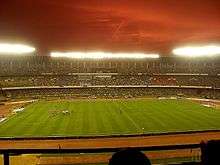

A planned city, Bidhannagar offers many facilities usually not available in many of the other older Indian cities. It has clean and well-maintained roads and sanitation, tree-clad boulevards, relatively pollution free environment, its own swimming pool, a large number of schools and educational institutions, the largest sports stadium in India and the second-largest stadium in the world by capacity, the Yuva Bharati Krirangan, modern shopping malls such as City Centre, INOX multiplex, RDB Big Cinemas multiplex, Nicco Park (an amusement park), the Netaji Subhas Sports Institute, a 5-star hotel (Hyatt Regency) and a vast array of Government offices that cater not only to the local town but to the entire city of Kolkata. Originally, Bidhannagar had been designed to accommodate the entire administrative apparatus of greater Kolkata, but this idea was dropped early during the planning.
Nicco Park, the first amusement park in eastern India, is located in the Sector IV, so also the Nalban Boating Complex. One of the largest shopping mall of Kolkata, City Centre, has come up near Central Park in 2004 with a built-up area of 400,000 sq ft (37,000 m2).
Bidhannagar also contain few very good private and Government hospitals like AMRI, Anandalok Hospital, Kolkata Heart Research Institute, Columbia-Asia, Bidhannagar Sub Divisional Hospital etc.
Apart from this, there are 3 police stations, electricity offices, water supply tanks, sewerage water plants etc. as civic infrastructure. However, poor street lighting has made petty theft and eve teasing a recurrent problem. Another police station is likely to come up for policing only the sector V- the Information Technology hub.
The Information Technology hub is the centre of some of the notable IT/ITES Indian and multinational companies such as TCS, IBM, CTS etc.
Bidhannagar is also home to Central Park,(also called Banabitan) the largest park in the Kolkata urban area after the Maidan. Like the town it is situated in, it too has a more famous namesake in USA. The Central Park, which is about 100 acres (0.40 km2), and comprises Banabitan administered by the Forest Department, the statues of Netaji Subhas Chandra Bose and Swami Vivekananda and Kaji Najrul Islam, a central store of the Urban Development Department, has already been subjected to a greater scrutiny by the KMDA (Kolkata Metropolitan Development Authority). The KMDA has been planning comprehensively for chalking out a master development plan for the beautification of the Central Park of Bidhannagar. The Central Park is regarded as the "Lung of Bidhannagar".
IT Hub-Sector V and Sector III
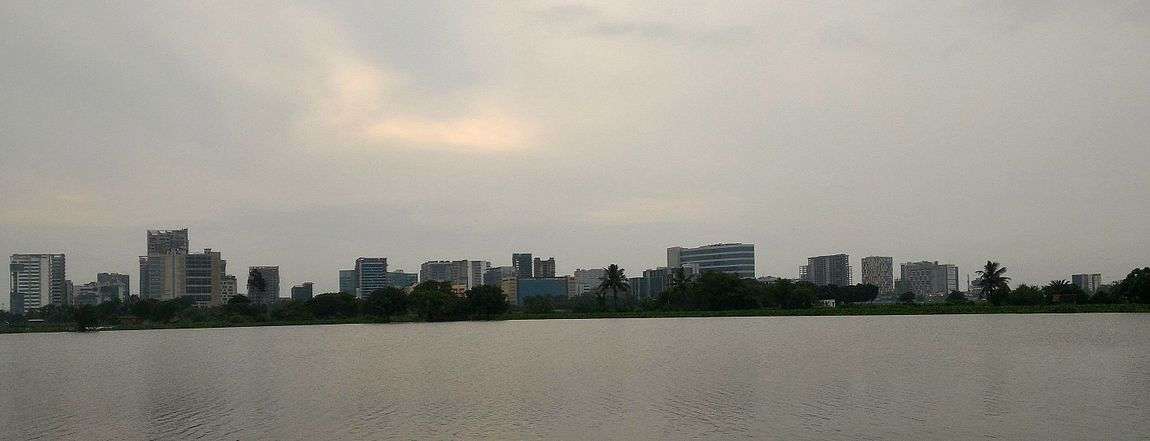
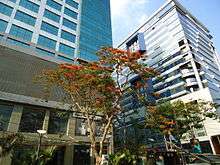
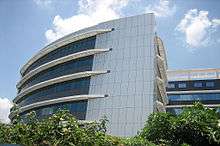
The Information Technology hub is the centre of some of the notable IT/ITES Indian and multinational companies. Around 1.2 Lakh people are Employed in Sector V and Sector III. The area is administered by Naba Diganta Industrial Township Authority.
Some of the companies located in Here includes:
Business Strategy Consulting
- PwC, also serves as the India Headquarters
- Frost & Sullivan
- KPMG
- Ernst & Young
- AC Nielsen
IT Companies
- TCS
- Accenture
- Sanpro Info Solution
- Indusnet Technology
- Wipro
- ITC Infotech
- Deloitte
- Cognizant Technology Solutions
- IBM
- CISCO
- Capgemini
- Tech Mahindra
- Ericsson Global Services
- Genpact
- Tata Interactive Systems
- HCL Technologies
- NIIT Technologies
- HSBC Global Resourcing
- Microsoft Development Centre
- CMC Limited
- Firstsource
- WEBEL
- Foster wheeler
- American Reprographics Company
- Mphasis FinSolutions
- MuSigma
- Lexmark
- Atos Origin
- Minacs
- Siemens IT Solutions and Services
- SYNTEL
- Larsen & Toubro
- Sun Microsystems
- HP
- Collabera
- DELL
- RS Software
- Globsyn Ltd.
- Aegis
- IKF
- Karmick Solutions
- iMorphosis
Education
Bidhannagar is home to several academic, research and professional institutions of National Importance.
Colleges
- Maya Academy of Advanced Cinematics
- Institute of International Trade
- Brainware College of Professional Studies
- Indian Institute of Foreign Trade, Kolkata
- Saha Institute of Nuclear Physics
- Variable Energy Cyclotron Centre
- S.N. Bose National Centre for Basic Sciences
- Bidhannagar College of the West Bengal State University
- Bose Institute
- All India Institute of Hygiene and Public Health (Second campus)
- Technical Teacher's Training Institute
- Government College of Engineering and Leather Technology
- University of Calcutta's technology campus
- Jadavpur University's second campus
- The Institution of Electronics and Telecommunication Engineers (IETE)
- West Bengal University of Technology
- West Bengal National University of Juridical Sciences
- The Kolkata extension campus of IIT Kharagpur
- National Institute of Fashion Technology
- Institute of Engineering and Management
- Indian Institute of Science Education and Research, Kolkata
- Techno India University
- National Institute of Homoeopathy
- National Council of Science Museums
- International School of Business and Media
- Unitedworld School of Business
- Rabindra Bharati University
- Aliah University
- Institute for Inspiration & Self Development
Schools
Schools in Bidhannagar include the Haryana Vidya Mandir, Bidhannagar Government High School, Bidhannagar Municipal School, a combined primary and high school and a branch of Bharatiya Vidya Bhavan, named Bhavan's Gangabux Kanoria Vidyamandir, Salt Lake School , Mother International School, Sri Aurobindo Institute of Education, Laban Hrad Vidyapith. Also there are two Kendriya Vidyalaya in Salt Lake viz. K.V. No. 1 & K.V. No. 2 Salt Lake.
Catholic schools include Our Lady Queen of the Missions School and St. Francis Xavier School.
Transport
CSTC Buses
- AC Bus
- AC4A Parnasree – Sapoorji Housing Estate
- AC9 Jadavpur – Salt Lake Karunamoyee
- AC9B Jadavpur – Ecospace
- AC14 Baruipur – Salt Lake Karunamoyee
- AC17 Thakurpukur – Salt Lake Karunamoyee
- AC23A Bally Halt – Salt Lake Depot
- AC25 Dunlop – Salt Lake Depot
- AC37A Airport Terminal – Garia Bus Stand
- AC41 Santragachi – Ecospace
- AC43 Airport Terminal – Golf Green
- AC47 Kudghat – Sapoorji Housing Estate
- Non AC Bus
- S3W Joka – Ecospace
- S4 Parnasree – Salt Lake Depot
- S4B Haridebpur – New Town
- S4D Parnasree – New Town
- S9 Jadavpur – Salt Lake Karunamoyee
- S9C Patuli – Ecospace
- S12 Howrah Station – New Town
- S12E Howrah Station – Ecospace
- S14C Dunlop – Unitech
- S16 Thakurpukur – Salt Lake (Laboni)
- S22 Shakuntala Park – Salt Lake Karunamoyee
- S22A Dakghar – Salt Lake Karunamoyee
- S23A Bally Halt – Salt Lake Depot
- S30 Ultadanga – Ecospace
- S30A Ultadanga – Salt Lake - CIRCULAR ROUTE
- S46 Akra Santoshpur – Salt Lake Karunamoyee
- S53 Kolkata Railway Station – Unitech
CTC Buses
- Non AC Bus
- C8 Barasat – Joka
- C8A Airport Gate No.1 – Tollygunge
- C23 Dankuni Housing Estate – Park Circus
- C25 Howrah Station – Bikash Bhawan
- AC Bus
WBSTC Bus Routes
- ST7 Ultadanga – Unitech
- ST7A Ultadanga – Hatisala
- ST10 Santragachi – Balaka Abasan
- ST12 Baruipur – Sapoorji Housing Estate
- ST13 Bagbazar – Balaka Abasan
- ST15 Ultadanga – Ecospace
Private Bus Routes
- 12C/2 Howrah Station – Thakdari
- 32A Dakshineshwar – Salt Lake Sector 5
- 43/1 Ariadaha – Salt Lake Karunamoyee
- 44A Howrah Station – Salt Lake Sector5
- 47 Lake Town VIP More – Unitech
- 47/1 Tollygunge – Salt Lake Tank No.12
- 201 Nimta – Salt Lake Sector 5
- 206 New Garia Station – Salt Lake AJ Block
- 211B Ahiritola – Ganraguri
- 215A Howrah Station – Salt Lake Technopolis
- 215A/1 Howrah Station – Salt Lake Mahisbathan
- 235 Amtala – Salt Lake Karunamoyee
- 239 Babughat – Salt Lake Tank No.12
- 239B Howrah Station – Unitech
- 260 Acquatica – Alipore Zoo
Mini Bus Routes
- 5 Japanigate – Salt Lake Sector 5
- 17 Belgachia – Salt Lake Technopolis
- 20A Mourigram – Salt Lake Tank No.13
- 29 Tikiapara – Salt Lake Technopolis
- 122 Jadavpur – Purbachal
- 139/1 Rabindra Sadan – Salt Lake Technopolis
- 167 B.B.D. Bagh – Salt Lake KB, KC Block
- 173 Howrah Station – Salt Lake Karunamoyee
- 173 Howrah Station – Salt Lake Bikash Bhawan
DN Series of Routes
- DN8 Barasat Checkpost – Salt Lake Karunamoyee
- DN46 Dankuni Housing Estate – Salt Lake Karunamoyee
- DN47 Barasat Checkpost – Salt Lake Karunamoyee
JM Series of Routes
- JM1 Dhulagarh – Salt Lake
KB Series of Routes
- KB12 Rabindranagar – Unitech
- KB16 Bangur – Sapoorji Housing Estate
- KB17 Sonarpur Khiristala – Salt Lake Karunamoyee
- KB22 Shibtala Math – Patharghata (Sapoorji Housing Estate)
K Series of Routes
- K1 Kolkata Railway Station – New Town (Hatisala)
- K2 Airport Gate No.1 – Salt Lake 206 Bus Stand
WBSTC AC Bus Routes
- V Series
- V9 Tollygunge – Unitech
- V13 Rashbehari – Unitech
- VS Series
- MW Series
- MW1 Jadavpur Sulekha – Unitech
- MW2 Howrah Station – Unitech
HIDCO Bus Routes
- Non AC Bus
- AC Bus
Nuvo Bus Transit Routes
Bus Routes without Numbers
- Dhulagarh – New Town (Unitech) (via Sealdah)
- Dhulagarh – New Town (Unitech) (via Park Circus)
- Dhulagarh – Chingrighata
- Kadamtala – New Town
- Domjur – Dum Dum Station – Salt Lake 206 Bus Stand
- Rajchandrapur – Salt Lake 206 Bus Stand
- Gadiara – New Town
- Amta – New Town
- Bagnan – Salt Lake Technopolis
- Gajar More – Salt Lake 206 Bus Stand
- Bally Halt – Salt Lake
- Nabanna – Rajarhat
- Sankrail Station – New Town
- Andul Station – Ecospace
- Dankuni – Ecospace
- New Garia Station – Salt Lake Karunamoyee
- Barasat – New Town – Santragachi
OTHER Buslines
- Barasat – Santragachi
- Barasat – Shibpur Botanical Garden
- Chakla - Saltlake Karunamoyee
- Rajarhat - Nabanna
- Tarakeswar - Saltlake Karunamoyee
- Turka - Saltlake Karunamoyee
- Digha - Saltlake Karunamoyee
- Ghatal - Saltlake Karunamoyee
INTERNATIONAL Buslines
SBSTC Buslines
- Saltlake Karunamoyee - Burdwan
- Saltlake Karunamoyee - Asansol
- Saltlake Karunamoyee - Durgapur
- Saltlake Karunamoyee - Bankura
- Saltlake Karunamoyee - Digha
Further development
A new township thrice the size of Salt Lake is coming up further east in Rajarhat under the name of New Town.
References
- ↑ "6. State of Literacy" (PDF). Census of India 2011. p. 98. Retrieved 28 January 2012.
- ↑ "Cities having population 1 lakh and above" (PDF). Census of India. 2011. p. 7. Retrieved 28 January 2012.
- ↑ Falling Rain Genomics, Inc - Bidhannagar
- ↑ In Bengali, Nagar means City
- ↑ Will Bidhannagar be merged with KMC?
- ↑ Govt nod to new police posts, civic bodies’ merger The new corporation will thus be named Bidhannagar-Rajarhat-Gopalpur Municipal Corporation
External links
| Wikimedia Commons has media related to Bidhannagar. |
-
 Kolkata/East travel guide from Wikivoyage
Kolkata/East travel guide from Wikivoyage - Bidhannagar Municipal Corporation